NorthEast Radio Watch 12/8/2025: Cichon’s Back in Buffalo
In this week’s issue… Veteran newsman returns - Remembering NY's Leitner, RI's Jones - CT AM saved - Maine AM moves - "Indie" adds suburban signals
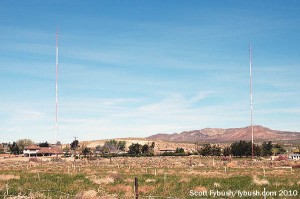
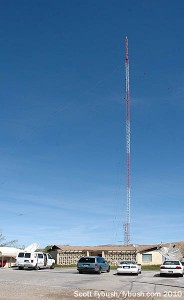
Careful readers of all of our Tower Site of the Week visits to southern California all these years may have noticed a pattern: almost all of our tours of Los Angeles-area sites take place in April.
That’s not just because April is usually a congenial time to visit the Southland – after all, almost any time of year finds pleasant weather there – it’s also a question of logistics. Being based on the other end of the country, it’s obviously much easier to work a Los Angeles visit in when we’re already heading west for something else, and of course every April for more than a decade has found us heading west to the NAB Show in Las Vegas.
Over the years, then, we’ve had ample opportunity become enamored as well of the drive from Vegas down to Los Angeles. There’s not much radio to check out on the first half of the drive – just a lot of desert vastness off both sides of the I-15 freeway, interrupted at Baker by a stop for a fresh strawberry shake at the Mad Greek. But the second half of the drive? That’s full of radio, as the desert gives way first to the small town of Barstow and then to the exurban sprawl of the Victor Valley…and then as the freeway heads over the pass into the “Inland Empire” cities of San Bernardino and down toward Riverside. As it happened, our April 2010 trip allowed for some big chunks of time to drive around and see some of the sites in all of those areas.
We start with Barstow, the commercial hub of the high desert. a dusty old railroad town where I-40 meets I-15 – and just north of that interchange and downtown Barstow, we find two small AMs. KIQQ (1310) is the Spanish-language AM up here, running 5000 watts by day and 120 watts by night into a two-tower array that sends most of its power up into the desert to the northeast; talker KSZL (1230) has its nondirectional tower and little studio building just to the west on Radio Road. (Every once in a while, you’ll actually see the building here double as a radio studio somewhere else in a TV show or a movie; it’s just scenic enough and just close enough to Los Angeles to have caught the eye of location scouts, it seems.)
Like any other community its size, Barstow has sprouted plenty of FM signals in the last few decades – there’s the “Highway Radio” group, based out of studios in the Barstow Station tourist stop along I-15, as well as KIQQ’s sister station, KIQQ-FM (103.7 Newberry Springs), and two Dos Costas sister stations to KSZL, rhythmic KDUC (94.3) and regional Mexican KXXZ (95.9), and Radio Lazer’s KBTW (104.5 Lenwood).
Instead of trying to get up to the inhospitable hilltop sites for the Barstow FMs, we headed south on the 15 for another half-hour to Victorville, the desert community that attracted plenty of long-distance commuters seeking lower housing prices in the 1990s. That led to a boom that lined the 15 corridor with shopping centers, filled the dial with local signals and even attracted some big players in the radio industry to expand their clusters out to the Victor Valley.
Clear Channel ended up with a cluster out here that included two AMs (KIXW 960 Apple Valley and KRSX 1590 Victorville) and four FMs (“Kat Country” KATJ 100.7 George, “AC “Y102” KZXY 102.3 Apple Valley, rocker KIXA-FM 106.5 Lucerne Valley and oldies KRSX-FM 105.3 Yermo/Barstow) before selling most of those stations to El Dorado Broadcasting, which operates most of those stations today from the old Clear Channel studios in an office complex south of Victorville and east of the 15 on Hesperia Road.
CBS Radio ended up here to extend the reach of its San Bernardino country giant, KFRG, which was heard for some years on Victorville satellite outlet KVFG (103.1). By 2010, KVFG was doing ESPN Radio when we drove by its modest studio building, also on Hesperia Road just south of El Dorado. Since then, ESPN has replaced “Stardust 910” standards on KVFG’s sister AM signal, KRAK, and the FM is now classic hits “103.1 the Route.” (This was the path, after all, of Route 66’s approach to the San Bernardino Mountains before dropping into the LA basin and ending at the Pacific Ocean.)
Most of the Victor Valley sprawls out east of the 15, but there’s at least one studio west of the freeway, too. KHIZ-TV (Channel 64) is licensed to Barstow, transmits from a hill north of Victorville, has nominal studio facilities here in northwest Victorville, and tries to serve Los Angeles via the miracle of cable and satellite must-carry. Just down the road from the KHIZ studios, the tower of Victorville’s AM 1590 used to be clearly seen right along the west side of the 15, but the construction of a noise-barrier wall along the freeway a few years back has blocked part of the view. With 500 watts by day and 130 watts at night, the 1590 signal here signed on in 1961 and used to be known as KCIN, KROY and KATJ(AM). It picked up the KRSX calls in part to fend off an unlicensed station in town that was operating on 660 as “Route 66 Radio, KRSX,” circa 2002. (That “Route 66 Radio” operation was a pretty nifty one, actually, playing great oldies with lots of jingles…)
Moving down the dial, KWRN (1550) out in rural Apple Valley, east of Victorville, is a two-tower directional regional Mexican station running 5000 watts by day, 500 watts at night. It’s another newcomer, having signed on in 1991.
Also out in Apple Valley is El Dorado’s English-language talk outlet. The oldest AM in the market, dating back to 1954, KIXW (960) used to have a directional array that allowed it to run 5000 watts by day and 400 watts at night. Today, development around the site on Rincon Road has pared this back to a non-directional facility running 5000 watts by day and just 20 watts at night from a site just south of Highway 18, the “Happy Trails Highway.” (Apple Valley, it should be noted, was the hometown of Roy Rogers and Dale Evans…)
From Apple Valley, we slide southwest into Hesperia, at the southern end of the Victor Valley, where we find our last stop in the market. KRAK (910 Hesperia) has the most elaborate directional array in the valley, all for the sake of 700 watts by day, 500 watts at night. This station signed on in 1990 as KVVQ, and took the KRAK calls in 2001 when CBS needed a place to park them after many, many years in Sacramento.
There was once one more AM out here, and that may be the best story of all. In the mid-1980s, legendary LA broadcaster Saul Levine secured a construction permit for KKGO(AM). A sister station to his KKGO-FM, the signal at 540 kHz ran 25,000 watts by day and 360 watts at night from a mammoth array of six very tall towers way out on the side of Highway 247 in Lucerne Valley, east of Apple Valley. After originally being licensed to Hesperia, Levine relicensed 540 to Costa Mesa, 90 miles away but well within reach of the booming directional signal from deep in the desert, and in due time 540 begat an expanded-band partner on 1650 that was actually located in populous Orange County instead of the empty desert. That station eventually moved up to Torrance, in Los Angeles County, where it’s now known as KFOX; 540, meanwhile, eventually went silent up in the desert, though not before spawning a synchronized signal just south of the border in Tijuana, now known as XESURF. The big 540 towers in Lucerne Valley were dismantled and sold off, but a satellite view of the site shows that the old ground system and transmitter building can still be seen. (Someday, we’ll have to go do just that.)
And we wrap up the California segment of this week’s feature on the other side of the San Bernardino Mountains, over the pass from Victorville and Hesperia.
On earlier trips some years back, we’d spent some time seeing the AM sites in and around San Bernardino, and one of these days we’ll either post those old pictures or go back for newer ones.
This time around, we wanted to check out some AMs we’d never seen in Riverside, south of San Bernardino. Riverside gets its name from its proximity to the Santa Ana River, and it’s near the east bank of that river just north of downtown Riverside that we find the fulltime non-directional 1000-watt signal on 1440 that was long known as KDIF. It was doing Spanish religion when we visited, but it flipped later in 2010 to full-time comedy as “Funny 1440,” KFNY.
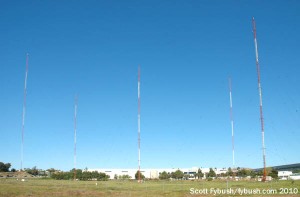
Before KDIF was KDIF, it was KPRO – and those calls eventually ended up on Riverside’s other AM at 1570 on the dial, the religious station formerly known as KHNY and KMAY. KPRO’s studio and four-tower array is on Lincoln Avenue south of downtown Riverside, where it runs 5000 watts by day and 190 watts at night.
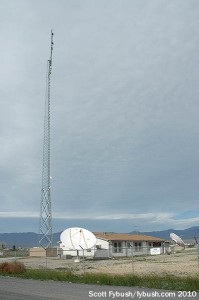
Our last stop in the Inland Empire finds us in Corona, southeast of Riverside at the spot where I-15 meets State Route 91, the freeway that goes from Riverside over the hills into Orange County.
At the southeastern corner of that interchange is the five-tower array of KWRM (1370 Corona), running 5000 watts from all five towers by day, 2500 watts from three of the towers at night. One of the day-only towers collapsed in a storm in January 2011, and KWRM has been operating with 1250 watts non-directional under STA ever since.
We close out this installment with one last picture from that April 2010 trip: before pulling into Las Vegas for the NAB Show, our last stop after a decidedly non-radio weekend in Death Valley was in the small town of Pahrump, 60 miles west of Las Vegas on the other side of the mountains.
If something about “Pahrump, Nevada” is tickling the radio part of your brain cells, it may well be that you’re a late-night listener who recognizes that desert town as the home of Art Bell, longtime host of “Coast to Coast AM.”
Bell built a radio station out here in 2002, and KNYE (95.1) has been serving the “Kingdom of Nye” with oldies music ever since. (For a while, it even reached into Las Vegas on a translator at 100.1 on the dial that now relays a different Pahrump-area signal, KHWG-FM 100.1 Crystal.) Bell sold KNYE to station manager Karen Jackson in 2008, but the station continues to carry “Coast to Coast AM” every night from 10 PM until 6 AM.
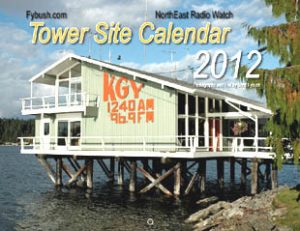 Don’t miss your chance to order the all-new Tower Site Calendar 2012, available now from the all new Fybush.com store!
Don’t miss your chance to order the all-new Tower Site Calendar 2012, available now from the all new Fybush.com store!
And check out our sister site, Tophour.com, beginning Wednesday, February 29, for Inland Empire and High Desert legal IDs…
Next week: Oswego, N.Y., summer 2011
In this week’s issue… Veteran newsman returns - Remembering NY's Leitner, RI's Jones - CT AM saved - Maine AM moves - "Indie" adds suburban signals
In this week’s issue… Scripps stations face takeover - Sinclair moves more affiliations - CT stations sold - Maine AM surrendered - Remembering WVBR's Shapiro, WABC's Morgan
In this week’s issue… CT TV legend succumbs to cancer - Remembering PA's Adams - FCC still stalled by shutdown - Pittsburgh morning host exits
In this week’s issue… FCC faces reopening challenges - Veteran Boston anchor retires - Morning shift in Toronto - NYC FMs expand reach